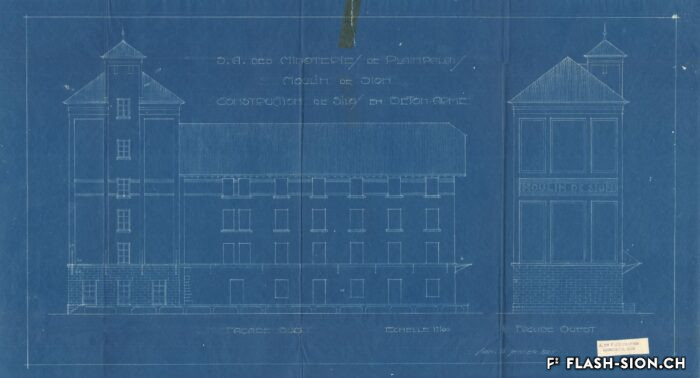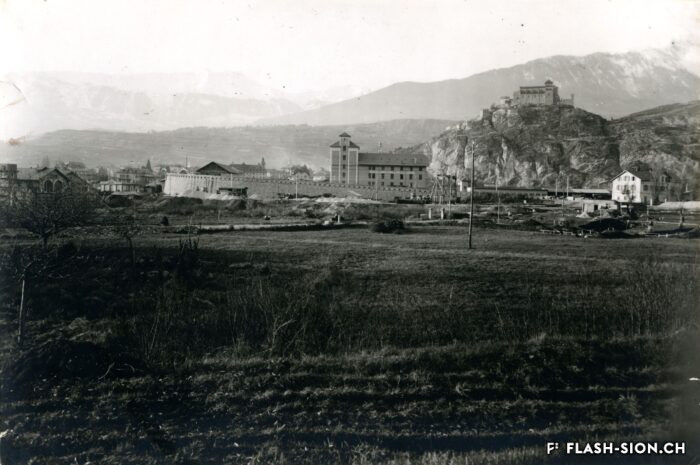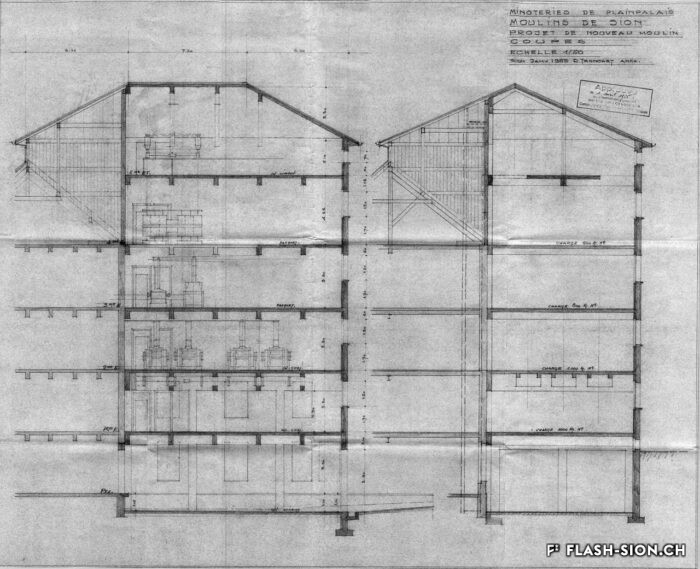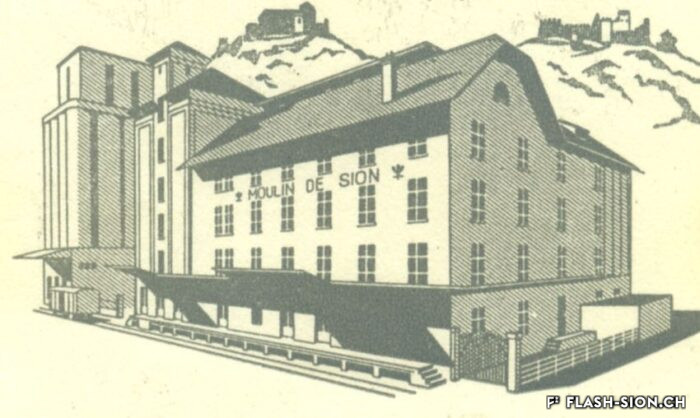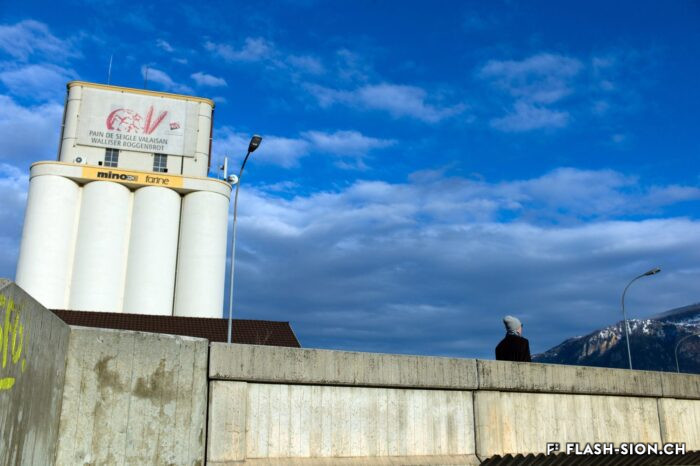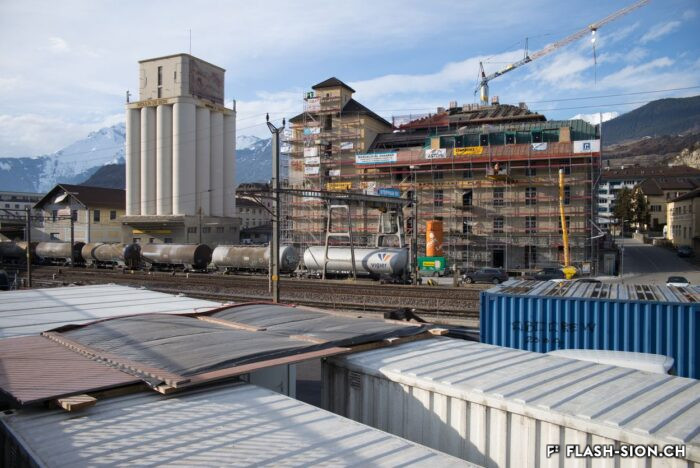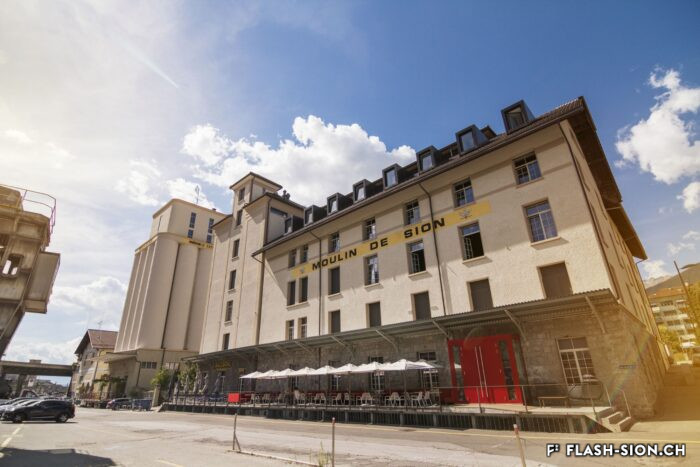Un moulin à la pointe
Après une tentative infructueuse à l’aube du 20e siècle, les Minoteries de Plainpalais (Genève) ouvrent une succursale à Sion en 1919. Le Moulin de Sion, entreprise d’importance pour le développement économique du Valais, s’agrandit rapidement. Les premiers silos en béton armé sont construits en 1925. Un peu moins de 15 ans plus tard, il faut en édifier d’autres. Le complexe continue de s’étendre jusqu’en 1980. Au fil du temps, les techniques évoluent et, dès 1984, les opérations sont entièrement automatisées. Le Moulin de Sion est alors un des plus modernes d’Europe ! Suite à l’obtention du label AOC pour le pain de seigle – premier pain d’Europe à le recevoir –, le Moulin de Sion se consacre entièrement à la fabrication de la farine de seigle. En 2015, la production est déplacée à Naters et le bâtiment peut alors être totalement réaffecté. Tout en conservant son apparence extérieure, les lieux accueillent désormais restaurants, fitness, bureaux et appartements notamment.
Modernste Mühlentechnik
Nach einem erfolglosen Niederlassungsversuch zu Beginn des 20. Jahrhunderts eröffnen die Minoteries de Plainpalais (Genf) schliesslich 1919 eine Zweigstelle in Sitten. Die Mühle von Sitten nimmt in der wirtschaftlichen Entwicklung des Wallis eine wichtige Stellung ein und wird schon nach kurzer Zeit ausgebaut. 1925 entstehen die ersten Silos aus Stahlbeton. Nur knapp 15 Jahre später, werden weitere Silos erstellt. Bis 1980 wird der Mühlenkomplex kontinuierlich erweitert und die Mühlentechnik modernisiert. Ab 1984 wird der Betrieb schliesslich vollständig automatisiert. Die Mühle Sitten zählt zu dieser Zeit zu einem der modernsten Betriebe Europas! Nach dem Eintrag des Walliser Roggenbrotes ins Register der Ursprungsbezeichnung (GUB) – das erste Brot in Europa mit dieser Bezeichnung – widmet sich die Mühle Sitten ganz der Herstellung von Roggenmehl. 2015 wird die Produktion nach Naters verlegt und die Industriebrache wird vollständig umgenutzt. Das äussere Erscheinungsbild der Mühle bleibt erhalten, der Gebäudekomplex beherbergt jedoch neu verschiedene Restaurants, ein Fitnesscenter, Büroräumlichkeiten und moderne Wohnungen.
A mill at the forefront
After an unsuccessful attempt at the beginning of the 20th century, the Minoteries de Plainpalais (Geneva) opened a branch in Sion in 1919. The Moulin de Sion (Mill of Sion), an important company for the economic development of Valais, expanded rapidly. The first reinforced concrete silos were built in 1925. A little less than 15 years later, others had to be built. The complex continued to expand until 1980. Over time, technologies evolved and, in 1984, operations were fully automated. The Moulin de Sion became one of the most modern in Europe! After obtaining the AOC (PDO) label for rye bread – the first bread in Europe to receive it – the Moulin de Sion devoted itself entirely to the production of rye flour. In 2015, production was moved to Naters and the building’s function was completely reassigned. While retaining its external appearance, the premises now house restaurants, fitness centres, offices and flats, among other things.
Un mulino all’avanguardia
Dopo un tentativo fallito all’inizio del XX secolo, i mulini di Plainpalais (Ginevra) aprirono una filiale a Sion nel 1919. Il Moulin de Sion, un’azienda importante per lo sviluppo economico del Vallese, si espanse rapidamente. I primi silos in cemento armato furono costruiti nel 1925. Poco meno di 15 anni dopo, è stato necessario costruirne altri. Il complesso continuò ad espandersi fino al 1980. Nel corso del tempo, le tecniche si sono evolute e, a partire dal 1984, le operazioni sono state completamente automatizzate. Il Moulin de Sion è diventato così uno dei più moderni d’Europa! Dopo aver ottenuto il marchio AOC per il pane di segale – il primo pane in Europa a riceverlo – il Moulin de Sion si è dedicato interamente alla produzione di farina di segale. Nel 2015 la produzione si è spostata a Naters e l’edificio ha potuto essere completamente riutilizzato. Pur mantenendo il suo aspetto esterno, i locali ospitano oggi, tra l’altro, ristoranti, centri fitness, uffici e appartamenti.

